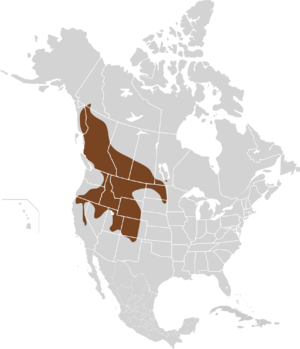Western jumping mouse facts for kids
Quick facts for kids Western jumping mouse |
|
|---|---|
 |
|
| Conservation status | |
| Scientific classification | |
| Genus: |
Zapus
|
| Species: |
princeps
|
 |
|
The western jumping mouse (Zapus princeps) is a small rodent that can jump! It belongs to a special group of mice called Zapodidae. You can find these mice living in Canada and the United States.
These amazing jumpers have been around for a very long time, since the Pleistocene Ice Age. They are closely related to Pacific jumping mice. In fact, they can even have babies together!
Contents
What Does a Western Jumping Mouse Look Like?
Western jumping mice might look like regular mice at first glance. But they have some special features! They have long back feet and smaller front legs, which help them jump.
Size and Color
These mice are about 22 to 25 centimeters (9 to 10 inches) long. This includes their long tail, which is about 13 to 15 centimeters (5 to 6 inches) long. They weigh between 17 and 40 grams (0.6 to 1.4 ounces). That's about as much as a few strawberries!
Their fur is rough and dark grayish-brown on top. They have a wide yellow or red stripe along their sides. Their belly is a light yellowish-white color. Sometimes, a mouse might even have white spots on its back or tail tip. Male and female mice look very similar in size and appearance.
Where Do Western Jumping Mice Live?
Western jumping mice live in western North America. You can find them from Yukon in Canada all the way down to New Mexico in the United States.
Their Favorite Homes
They love to live in mountains where the weather is a bit damp. You'll often find them in meadows and forests. These forests usually have lots of alder, aspen, or willow trees. They especially like places with thick plants and close to fresh water.
There are many different types, or subspecies, of western jumping mice. Each type lives in a slightly different area. For example, some live in Colorado, while others are found in Oregon or British Columbia.
How Do Western Jumping Mice Live?
Western jumping mice are omnivores, which means they eat both plants and insects. Most of their diet is made up of seeds from grasses and other plants. They also enjoy fruits, fungi (like mushrooms), and insects.
Finding Their Food
You can tell where these mice have been eating. They often leave small piles of grass stems that have had their seeds stripped off. They also make clear paths through the grass, which are covered with grass clippings. They build their nests out of grass pieces. They hide these nests under plants or other things on the ground.
Night Owls and Long Sleepers
These mice are nocturnal, meaning they are active at night. But here's a cool fact: they are only active during the summer months! For the rest of the year, they are in a deep sleep called hibernation. In some places, they hibernate for eight to ten months!
During hibernation, they don't eat. They live off the fat they stored in their bodies. A mouse might lose about 25% of its body weight during this long sleep. They don't sleep the whole time, though. They wake up for a short time about once every 38 days.
They start hibernating when the first snow falls, or even earlier. They wake up when the ground gets warm enough, usually around 8 to 9.5 degrees Celsius (46 to 49 degrees Fahrenheit).
Staying Safe from Predators
Many animals like to eat western jumping mice. These include bobcats, weasels, skunks, raccoons, snakes, and birds of prey (like hawks or owls).
When a mouse feels threatened, it makes a quick series of long jumps to escape. Then it freezes in place to hide. Normally, they make small hops or jumps up to 36 centimeters (14 inches). But when they are scared, their jumps can be much longer! They can leap up to 72 centimeters (28 inches) along the ground and 30 centimeters (12 inches) into the air.
Life Cycle and Reproduction
Female western jumping mice are ready to have babies about a week after they wake up from hibernation. They usually have only one litter of babies each year.
Baby Mice
The mother mouse is pregnant for about 18 days. Then she gives birth to a litter of four to eight tiny babies. The pups are born blind and have no fur. They weigh about 0.8 grams (0.03 ounces) – that's super tiny! They drink their mother's milk until they are about 28 to 35 days old.
Most young mice can have their own babies after their first hibernation. However, only about 40% do. The rest wait another year. Western jumping mice usually live for three to four years.


